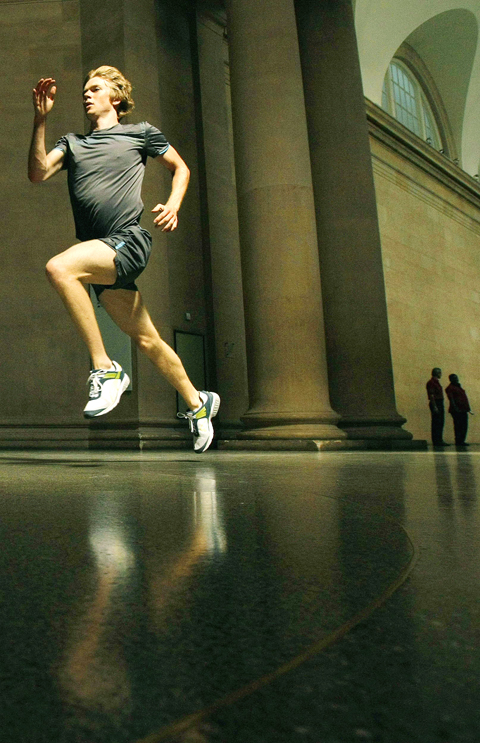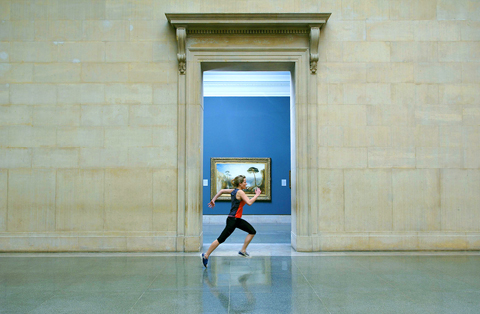Martin Creed cheered up the Turner prize no end seven years ago, when he won the award for a piece that consisted of a gallery’s lights being switched on and off. The work was called The Lights Going On and Off.
Now the artist is back with a new piece that is likely to prove just as irritating to traditionalists.
Creed’s Work No 850 is a single athlete running at top speed through the Duveen galleries at Tate Britain in central London — every 30 seconds, all day, every day.

PHOTO: AGENCIES
It is the latest in a series of sculpture commissions to occupy the elegant neoclassical galleries, which stretch back 86m from the museum’s main entrance on the banks of the Thames. Visitors to Tate Britain will see a runner streak past them, dashing “as if their life depended on it,” according to the artist’s instructions.
After a runner has made the 86m sprint (which will take about 12 seconds) there will be a 15-second pause — like a rest in a piece of music, according to Creed. Then the next runner will dash forth.
The runners have been recruited from various athletics magazines. Each will work a four-hour shift, with sprints interspersed with rests. They are to be paid US$20 an hour; and the Tate will be recruiting more runners through its Web site in due course. “We’re desperate to find enough people to keep it going for eight hours a day until November,” said Creed.

PHOTO: AGENCIES
“As soon as I was asked [to tackle the Duveen Galleries] I immediately thought of people running through them,” he said. “I wanted to use the whole space, instead of putting an object in it. The runner is like a guide showing you the whole space.”
The piece has a certain mystery to it: why is the runner running? To what? From what? “They are running urgently,” said Creed, “to complete the work.”
Is it pretentious, asked someone. “No, it is not pretentious. No one is pretending. They are just running,” said Creed.
“And is it art?” ventured another. “It’s not for me to say what art is. I hope people enjoy it and I hope they find something in it. I make my work because I want to make my life better, to make things exciting and fun and enticing.”
The appeal of the running figure, according to the artist, is simple: “Running is a beautiful thing. You do it without a pool, or a bike; it is the body doing as much as it can on its own.”
The pauses between the sprints, he said, provide a “frame” for looking at the runner, helping him to “display someone running.” He also likened the gallery to a theater, “a theater for looking at things.”
In some ways, Work 850 is not so far removed from the exhibition that has just come down from the Duveen Galleries: a lavish confection of neoclassical sculpture with Canova’s Three Graces as its climax. Like that display, Work 850 encourages the viewer to focus on the human form — but this time the body, far from locked in marble motionlessness, is galloping hell for leather.
“Running is the opposite of being still. If you think about death as being completely still and movement as a sign of life, then the fastest movement possible is the biggest sign of life. So then running fast is like the exact opposite of death: it’s an example of aliveness,” said Creed.
It was crucial, he said, that there should be no separation between runners and visitors; that the runners should have to weave past visitors and the visitors should be able to experience the runners directly, without a roped-off area. Nevertheless, those who take it upon themselves to join in the fun will be peremptorily stopped by museum security. “Running is not allowed in the galleries,” said Creed.
Part of the inspiration for the piece had come, he explained, when he was trying to visit the catacombs of the Capuchin monks in Palermo. Arriving just before closing time, Creed and his friends had only five minutes to see the museum — so they ran through it, trying to glimpse the display of dead bodies at a trot.
“It made me think, why do we have to look at paintings for a long time?” he said. “Why not just look for a second? One way isn’t necessarily better than another way. When I go to see a painting I like I sometimes feel very self-conscious as I stand before it, thinking, ‘I am now having the experience of looking at art.’”
Creed, who was born in 1968 in Wakefield, is currently in training. In about a month, he thinks, he will be sufficiently fit to take part in his own work.

On April 26, The Lancet published a letter from two doctors at Taichung-based China Medical University Hospital (CMUH) warning that “Taiwan’s Health Care System is on the Brink of Collapse.” The authors said that “Years of policy inaction and mismanagement of resources have led to the National Health Insurance system operating under unsustainable conditions.” The pushback was immediate. Errors in the paper were quickly identified and publicized, to discredit the authors (the hospital apologized). CNA reported that CMUH said the letter described Taiwan in 2021 as having 62 nurses per 10,000 people, when the correct number was 78 nurses per 10,000

As Donald Trump’s executive order in March led to the shuttering of Voice of America (VOA) — the global broadcaster whose roots date back to the fight against Nazi propaganda — he quickly attracted support from figures not used to aligning themselves with any US administration. Trump had ordered the US Agency for Global Media, the federal agency that funds VOA and other groups promoting independent journalism overseas, to be “eliminated to the maximum extent consistent with applicable law.” The decision suddenly halted programming in 49 languages to more than 425 million people. In Moscow, Margarita Simonyan, the hardline editor-in-chief of the

Six weeks before I embarked on a research mission in Kyoto, I was sitting alone at a bar counter in Melbourne. Next to me, a woman was bragging loudly to a friend: She, too, was heading to Kyoto, I quickly discerned. Except her trip was in four months. And she’d just pulled an all-nighter booking restaurant reservations. As I snooped on the conversation, I broke out in a sweat, panicking because I’d yet to secure a single table. Then I remembered: Eating well in Japan is absolutely not something to lose sleep over. It’s true that the best-known institutions book up faster

Though the total area of Penghu isn’t that large, exploring all of it — including its numerous outlying islands — could easily take a couple of weeks. The most remote township accessible by road from Magong City (馬公市) is Siyu (西嶼鄉), and this place alone deserves at least two days to fully appreciate. Whether it’s beaches, architecture, museums, snacks, sunrises or sunsets that attract you, Siyu has something for everyone. Though only 5km from Magong by sea, no ferry service currently exists and it must be reached by a long circuitous route around the main island of Penghu, with the